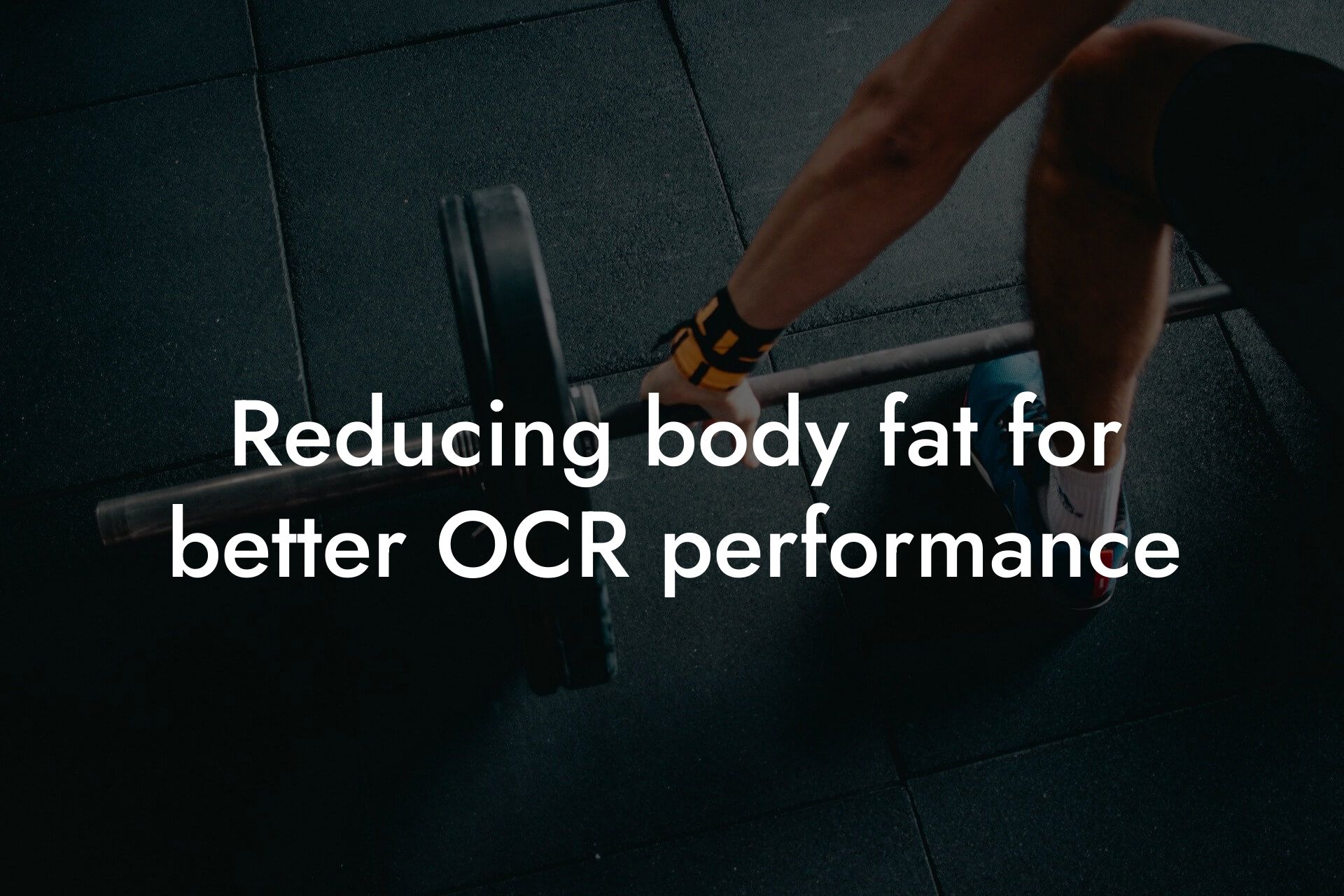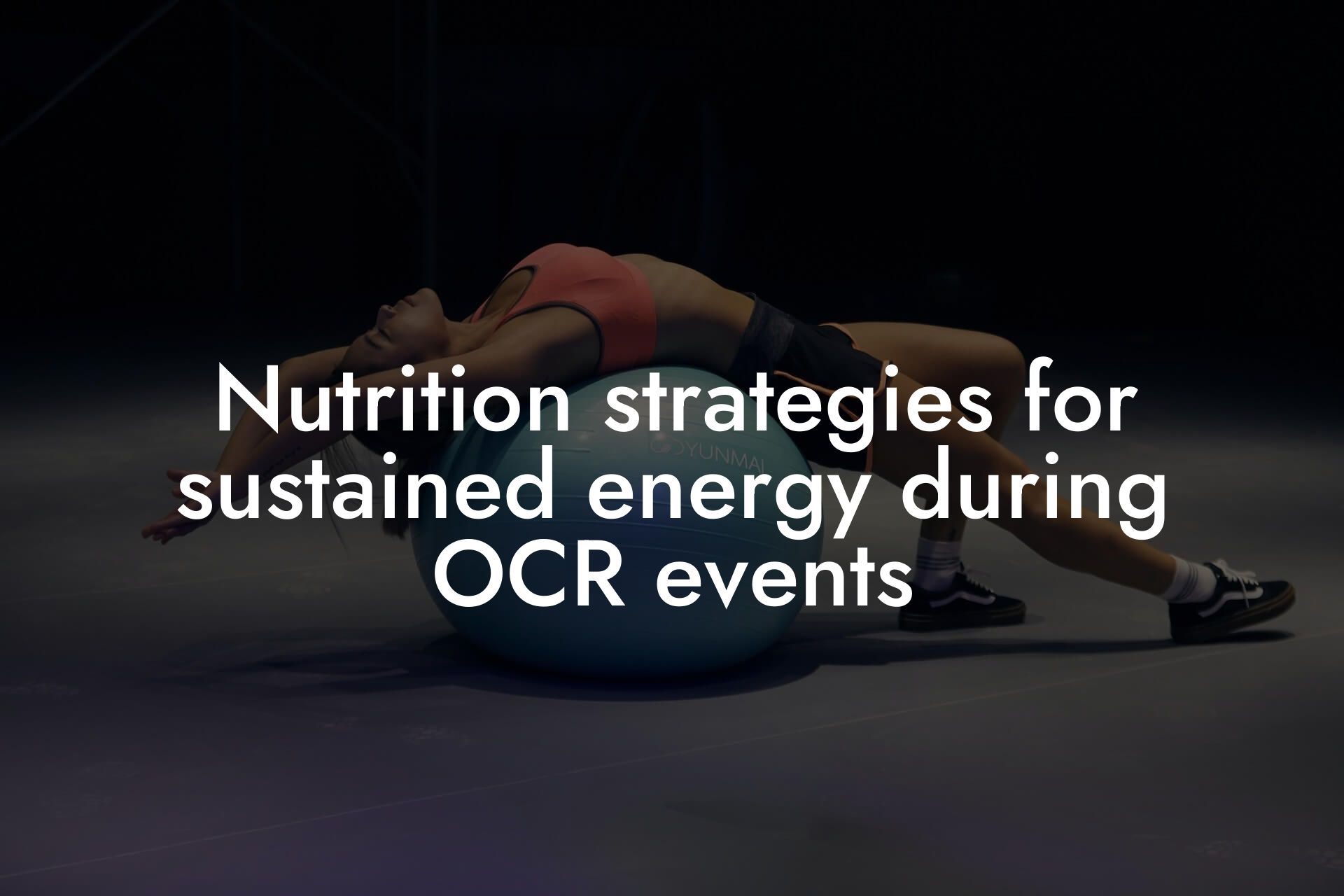As an obstacle course racer, you understand the importance of having a well-rounded fitness level to tackle the demands of the course. While cardiovascular endurance and muscular strength are crucial, body composition plays a significant role in determining your overall performance. In this article, we'll delve into the significance of body composition in obstacle course racing and how it can impact your results.
Table of Contents
- What is Body Composition?
- Why is Body Composition Important in Obstacle Course Racing?
- How Does Body Composition Affect Obstacle Course Racing Performance?
- Optimal Body Composition for Obstacle Course Racing
- How to Improve Body Composition for Obstacle Course Racing
- Common Mistakes Obstacle Course Racers Make with Body Composition
- Frequently Asked Questions
What is Body Composition?
Body composition refers to the percentage of fat mass and lean mass in your body. Lean mass includes muscle, bone, and water, while fat mass is comprised of essential and storage fat. Having an optimal body composition is essential for obstacle course racers, as it directly affects their power-to-weight ratio, agility, and endurance.
Why is Body Composition Important in Obstacle Course Racing?
In obstacle course racing, a high percentage of body fat can hinder performance in several ways. Excess fat increases your overall weight, making it more challenging to climb, jump, and crawl through obstacles. Additionally, it can reduce your power-to-weight ratio, making it more difficult to generate speed and agility. On the other hand, having a high percentage of lean mass can improve your overall performance by increasing your strength, power, and endurance.
How Does Body Composition Affect Obstacle Course Racing Performance?
Research has shown that obstacle course racers with a lower body fat percentage tend to perform better than those with a higher body fat percentage. This is because excess fat can impede movement, increase energy expenditure, and reduce overall speed and agility. In contrast, having a high percentage of lean mass can improve obstacle course racing performance by:
- Increasing strength and power
- Enhancing endurance and stamina
- Improving agility and speed
- Reducing injury risk
Optimal Body Composition for Obstacle Course Racing
While there is no one-size-fits-all optimal body composition for obstacle course racing, research suggests that a body fat percentage between 10-15% for men and 15-20% for women is ideal. However, this can vary depending on individual factors such as age, sex, and genetics. A DEXA scan can provide a detailed analysis of your body composition, helping you identify areas for improvement.
How to Improve Body Composition for Obstacle Course Racing
Improving body composition for obstacle course racing requires a combination of proper nutrition, training, and recovery. Here are some tips to help you achieve an optimal body composition:
- Focus on whole, nutrient-dense foods such as lean proteins, complex carbohydrates, and healthy fats
- Incorporate strength training exercises to build lean mass
- Increase cardiovascular exercise to burn excess fat
- Get adequate rest and recovery to allow your body to adapt and rebuild
- Monitor your body composition regularly using a DEXA scan or other measurement tools
Common Mistakes Obstacle Course Racers Make with Body Composition
Many obstacle course racers make common mistakes that can hinder their performance and body composition. These include:
- Not monitoring body composition regularly
- Focusing solely on cardiovascular exercise and neglecting strength training
- Following fad diets or restrictive eating plans that can lead to muscle loss
- Not getting adequate rest and recovery
In conclusion, body composition plays a critical role in obstacle course racing performance. Having an optimal body composition can improve power-to-weight ratio, agility, and endurance, while excess fat can hinder performance. By understanding the importance of body composition, obstacle course racers can take steps to improve their performance and achieve their goals. Regular monitoring of body composition using a DEXA scan or other measurement tools can help identify areas for improvement and provide a competitive edge.
At Tano Performance Group, we understand the importance of body composition in obstacle course racing. Our DEXA machine provides a detailed analysis of your body composition, helping you identify areas for improvement and optimize your performance. Contact us today to learn more about how our services can help you take your obstacle course racing to the next level.
Frequently Asked Questions
What is obstacle course racing and why is body composition important?
Obstacle course racing (OCR) is a physically demanding sport that involves navigating through various obstacles, such as mud, walls, and barbed wire, over a set distance. Body composition plays a crucial role in OCR performance as it affects an athlete's power-to-weight ratio, endurance, and overall efficiency. A well-balanced body composition can help OCR athletes to perform better, reduce the risk of injury, and recover faster.
How does body fat percentage affect OCR performance?
Excess body fat can hinder OCR performance by increasing energy expenditure, reducing power output, and impairing endurance. A higher body fat percentage can also increase the risk of injury, particularly in obstacle-heavy sections of the course. On the other hand, a low body fat percentage can improve performance by reducing energy expenditure and enhancing power output.
What is the ideal body fat percentage for OCR athletes?
The ideal body fat percentage for OCR athletes varies depending on factors such as age, sex, and fitness level. Generally, a body fat percentage of 10-15% for men and 15-20% for women is considered optimal for OCR performance. However, it's essential to note that body fat percentage is just one aspect of body composition, and other factors such as muscle mass and bone density also play critical roles.
How does muscle mass affect OCR performance?
Muscle mass is essential for OCR performance as it provides the necessary power and strength to overcome obstacles. A higher muscle mass can improve performance by increasing power output, reducing fatigue, and enhancing overall endurance. OCR athletes should aim to maintain a high muscle mass, particularly in their upper body, to improve their performance.
What role does bone density play in OCR performance?
Bone density is critical for OCR athletes as it affects their ability to withstand the physical demands of the sport. A high bone density can reduce the risk of injury, particularly in obstacle-heavy sections of the course, and improve overall performance. OCR athletes should incorporate exercises that promote bone density, such as weightlifting and plyometrics, into their training programs.
How can OCR athletes measure their body composition?
There are several methods to measure body composition, including dual-energy X-ray absorptiometry (DXA), skinfold measurements, and bioelectrical impedance analysis (BIA). OCR athletes should consult with a qualified healthcare professional or registered dietitian to determine the most appropriate method for their needs.
What are the benefits of tracking body composition for OCR athletes?
Tracking body composition can help OCR athletes to monitor their progress, identify areas for improvement, and adjust their training and nutrition programs accordingly. It can also help to reduce the risk of injury, improve performance, and enhance overall health and well-being.
How often should OCR athletes track their body composition?
OCR athletes should track their body composition regularly, ideally every 4-6 weeks, to monitor their progress and make adjustments to their training and nutrition programs as needed. This can help to ensure that they are on track to achieve their performance goals.
What is the relationship between body composition and obstacle course racing performance?
Body composition is a critical factor in OCR performance, as it affects an athlete's power-to-weight ratio, endurance, and overall efficiency. A well-balanced body composition can improve performance, reduce the risk of injury, and enhance overall health and well-being.
How can OCR athletes optimize their body composition for performance?
OCR athletes can optimize their body composition for performance by incorporating a balanced diet, regular exercise, and sufficient rest and recovery into their training programs. They should also focus on building muscle mass, reducing body fat percentage, and improving bone density to enhance their overall performance.
What are the consequences of poor body composition for OCR athletes?
Poor body composition can have severe consequences for OCR athletes, including reduced performance, increased risk of injury, and impaired overall health and well-being. Excess body fat can also increase the risk of chronic diseases, such as diabetes and cardiovascular disease.
How does nutrition affect body composition for OCR athletes?
Nutrition plays a critical role in body composition for OCR athletes, as it provides the necessary fuel for their bodies to function optimally. A balanced diet that includes adequate protein, complex carbohydrates, and healthy fats can help OCR athletes to build muscle mass, reduce body fat percentage, and improve bone density.
What are the key nutrients for OCR athletes to focus on?
OCR athletes should focus on consuming adequate amounts of protein, complex carbohydrates, and healthy fats to support their training and performance. They should also ensure that they are getting sufficient vitamins and minerals, particularly calcium and vitamin D, to support bone health.
How can OCR athletes incorporate strength training into their programs?
OCR athletes can incorporate strength training into their programs by including exercises such as weightlifting, plyometrics, and bodyweight exercises. They should focus on building strength in their upper body, legs, and core to improve their overall performance.
What are the benefits of high-intensity interval training (HIIT) for OCR athletes?
HIIT can help OCR athletes to improve their cardiovascular fitness, increase their power output, and enhance their overall endurance. It can also help to improve their body composition by increasing their muscle mass and reducing their body fat percentage.
How can OCR athletes incorporate cardio training into their programs?
OCR athletes can incorporate cardio training into their programs by including exercises such as running, cycling, and swimming. They should focus on building their cardiovascular endurance to improve their overall performance.
What are the benefits of flexibility and mobility exercises for OCR athletes?
Flexibility and mobility exercises can help OCR athletes to improve their range of motion, reduce their risk of injury, and enhance their overall performance. They should incorporate exercises such as yoga, Pilates, and stretching into their training programs.
How can OCR athletes incorporate recovery techniques into their programs?
OCR athletes can incorporate recovery techniques into their programs by including exercises such as foam rolling, self-myofascial release, and compression garments. They should also prioritize rest and recovery to allow their bodies to repair and adapt to the physical demands of OCR.
What are the benefits of working with a coach or trainer for OCR athletes?
Working with a coach or trainer can help OCR athletes to develop a personalized training program, improve their performance, and reduce their risk of injury. A coach or trainer can also provide valuable guidance and support to help OCR athletes achieve their goals.
How can OCR athletes stay motivated and focused during their training?
OCR athletes can stay motivated and focused during their training by setting clear goals, tracking their progress, and celebrating their achievements. They should also surround themselves with a supportive community of fellow athletes and coaches to help them stay motivated and accountable.
What are the benefits of joining an OCR community or team?
Joining an OCR community or team can provide OCR athletes with a sense of belonging, support, and accountability. It can also provide them with access to valuable resources, such as training programs and coaching, to help them improve their performance.
Here are some related articles you might love...
- Reducing body fat for better OCR performance
- Strength training tips specific to obstacle course racing
- Nutrition strategies for sustained energy during OCR events
- The importance of bone density in OCR performance
- Preventing injuries in obstacle course racing: A comprehensive guide
- Improving agility and strength for obstacle course racing
- Balancing strength, speed, and endurance in OCR training
- Maintaining muscle recovery with OCR training
- Using DEXA scans to monitor progress in obstacle course training
Zak Faulkner
Zak Faulkner is a leading authority in the realm of physical health and body composition analysis, with over 15 years of experience helping professionals optimise their fitness and well-being. As one the experts behind Tano Performance Group, Zak has dedicated his career to providing in-depth, science-backed insights that empower clients to elevate their physical performance and overall health.
With extensive knowledge of DEXA technology, Zak specializes in delivering comprehensive body assessments that offer precise data on body fat, muscle mass, bone density, and overall physique. His expertise enables individuals to make informed decisions and achieve their fitness goals with accuracy and confidence. Zak’s approach is rooted in a deep understanding of human physiology, combined with a passion for helping clients unlock their full potential through personalised strategies.
Over the years, Zak has earned a reputation for his commitment to excellence, precision, and client-focused service. His guidance is trusted by top professionals who demand the best when it comes to their health. Whether advising on fitness programs, nutritional strategies, or long-term wellness plans, Zak Faulkner’s insights are a valuable resource for anyone serious about taking their health and fitness to the next level.
At Tano Performance Group, Zak continues to lead our Content Team revolutionising how professionals approach their physical health, offering unparalleled expertise that drives real results.




